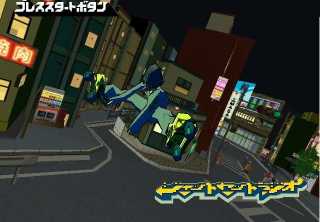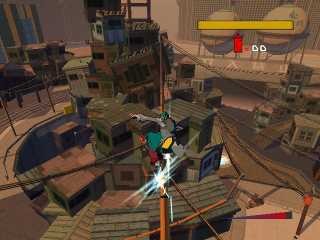History
Jet Grind Radio was announced at Tokyo Game Show 1999 and gained much attention due to a revolutionary style of graphics called "cel-shading". Jet Grind Radio was the first video game to feature this cartoon-like graphical style. Jet Grind Radio was released o the Sega Dreamcast in Japan on June 29, 2000, and was released on November 1 in the United States. The game did not sell well in the United States, but was critically acclaimed and gained a cult following. The sequel, Jet Set Radio Future, was released on February 25, 2002 for the Xbox. The game once again met with poor sales but critical acclaim. In 2003, a port of the original Jet Grind Radio was released on the Game Boy Advance. At Comic-Con 2008, rumors surfaced of a new Jet Grind Radio for the Wii. However, the rumors were silenced when comic book artist Cory "Rey" Lewis announced that Jet Grind Radio was proposed to Sega by Kuju Entertainment, though Sega turned them down. Lewis had created concept art for the proposed title.
Gameplay
The basic concept of Jet Grind Radio is simple. Each level has a time limit, a life meter and spots which you need to tag. The player must spray graffiti on designated locations. However, while the player tries to do this, the player will be met with resistance from law enforcement, at first just police officers with nightsticks but eventually helicopters with heat seeking missiles. There is also rival gangs to worry about as well.
Jet Set Radio
 Jet Set Radio.
Jet Set Radio.In this game, the player is given a set amount of time in which they must tag a number of designated spotsl. A trick system is featured - if the player jumps with enough speed, or lands on a grindable rail, a trick is automatically activated. The player may also to skate backwards by flicking the analog stick up and down. The tagging system is based around quick time events triggered when the player activates a tag location. When they do so, a quick time event occurs - the quick time consist of rotating the analog stick in certain directions that the game tells the player.
Jet Set Radio Future
 Jet Set Radio Future.
Jet Set Radio Future.The second game features a number of improvements from its predecessor. The game features an improved trick system. Tricks are activated by pressing the X button while grinding at a certain pace, and the way skating backwards is done is by pressing the Y button instead of flicking the analog stick up and down. The quick time tagging is removed - the player only has to activate a location to spray their tag. The timer from the original game is also removed. The player gains the ability to boost through the usage of 10 paint cans.
Story
The story of the Jet Set Radio series is about of group of "Rudies," who are also graffiti artists. They skate around the city of Tokyo-to, tagging their art work as a means of expressing themselves. The story centers around a gang that is known as the GGs. The leader of the gang in the original story is Beat, and in the second game is Corn (Known as Tab in the original). At first they go around and tag their art work while battling rival gangs like the Love Shockers, Poison Jam, and Noise Tank while trying not to get hunted down by the police. The ploat thickens when they find a mysterious record that can summon an ancient demon. A corporation known as the Rokkaku group are hunting for the record, and are kidnapping members of rival street gangs in an effort to discover this record.
The Story of the second game is basically a retelling of the story of Jet Set Radio. It's partly due to the fact that the developers of the game have stated that it's a re imagining and not a true sequel). Certain points of the story is told a bit differently - the game takes place in the future, more rival gangs are introduced in the story, and the Japanese police is led by different characters.
Jet Set Radio Re-Releases and Future Sequels
On July 24th, 2008, Sega filed a trademark for their Jet Grind Radio series, separate from the Dreamcast trademark. This, coupled with rumblings from "industry-insiders" in Comic-Con, opened speculation for a Wii sequel to the game. A post by Corey Lewis indicated that there was a pitch made to Sega from developer Kuju - now known as Headstrong Games - that was turned down by Sega.
Jet Set Radio was re-released for a number of digital platforms in 2012. Including consoles, handhelds and mobile devices. The hint for it's re-release first surfaced in a Kotaku article posted on April 25, 2010. The article showed a photo of a game called "Jet Set Radio" sitting in someone's game library on an Xbox 360 dashboard.
Log in to comment